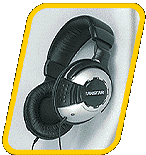Xitel Storm Platinum Gamer's Pack
by Mike Andrawes on June 13, 1999 9:37 PM EST- Posted in
- Smartphones
- Mobile
Force Feedback Headphones?
 The
Gamer's Pack from Xitel includes a pair of force feedback headphones. Wait a
minute. Force feedback headphones?!? Yep, that's what they're called.
The concept of force feedback on a pair of headphones at first seems quite strange,
but reading the description on the box actually gives a good idea of what they
do. The claim is that "it's like wearing a full surround sound system on
your ears, subwoofer included." Well, the Vortex 2 handles the surround
sound portion of that statement, and the force feedback handles the subwoofer
side of things.
The
Gamer's Pack from Xitel includes a pair of force feedback headphones. Wait a
minute. Force feedback headphones?!? Yep, that's what they're called.
The concept of force feedback on a pair of headphones at first seems quite strange,
but reading the description on the box actually gives a good idea of what they
do. The claim is that "it's like wearing a full surround sound system on
your ears, subwoofer included." Well, the Vortex 2 handles the surround
sound portion of that statement, and the force feedback handles the subwoofer
side of things.
But does it really work?
Actually, this is one of the few products in recent memory that actually went above and beyond expectations. It's not perfect, but it really does feel like you're wearing a subwoofer, or at least sitting near one. The claimed frequency response is 5Hz - 28kHz, which is actually wider than the typical human hearing range of 20Hz - 20kHz. Why go so low? You can still feel sounds below 20Hz, it's that sort of rumble you get during a suspenseful scene in a good movie theater. The sound quality won't impress audiophiles, but for just $20 when purchased in the Gamer's Pack, there aren't many better options at that price point. They're also available for $40 as a stand alone unit, which obviously doesn't offer as much value, but it is still a decent buy since a similar pair of Sony headphones, without force feedback, would run $60 or more.
However, the effect may be excessive if you're not really a huge bass head, especially while listening to bass heavy music. Fatigue can set in quickly if your music is bass heavy. It would have been nice if Xitel had included a level control for the force feedback effect (it doesn't despite the claims in the specifications). The other major problem with these headphones is the limited battery life with force feedback enabled - just 30 hours off a set of AAA batteries can add up quickly.
To partially remedy both these issues, there is an on/off switch for the force feedback effects on a control module in line with the headphone cable. Sound quality with force feedback disabled is a little weak in the lower frequencies. The control module also features a volume control that comes in really handy for making quick adjustments mid-game without going back to the options menu or Windows mixer.
The Test
The standard AnandTech test bed was used for all tests and consists of the following components:
- Intel Pentium II 400MHz, Intel Celeron 266 (0KB Cache)
- Abit BH6 i440BX Slot-1 mainboard
- 64MB Samsung Original PC100 SDRAM
- NVIDIA RIVA TNT AGP 16MB SDRAM
- Western Digital AC28400 - UltraATA
- Windows 98
The latest device drivers were used for all components. Tests were performed using Ziff Davis Audio Winbench 99. The graphics mode was 1024x768 in 16bit color.
Under these tests, CPU utilization for up to 32 DirectSound 3D streams was consistently well below 5%, even on a Celeron 266. Streaming up to 32 DirectSound sounds produced CPU utilization under 1%. Both of which are essentially negligible.
The Vortex 2, however, requires the CPU to do all vertex calculations based on the geometry of the environment from the game engine. This is not taken into account in Ziff Davis' Audio Winbench 99 that was used above. Using Half-Life and 3Finger's Blowout demo, the performance hit was about 10% in terms of frame rate on either CPU when A3D was enabled compared to standard stereo sound. For the hardcore gamer, this loss in frame rate may be unacceptable, but for most users, this is most likely bearable in light of the greatly enhanced audio offered by the Vortex 2 on the Storm Platinum. Those hard core gamer's who are still interested in 3D sound may wish to consider the Sound Blaster Live! that features a much simpler 3D implementation that is handled completely by the card.










5 Comments
View All Comments
iosman - Wednesday, May 9, 2018 - link
Im in love with your content and also gain some knowledge from your blog.https://appvalleyandroid.com
https://192-168-l-254-ip.com
https://psiphonapp.com
iosman - Wednesday, May 9, 2018 - link
Love your blog man. Thanks for this stuff.https://tweakbox-app.com
https://tweakbox-app.org
https://gameguardianapp.com
AbbeyGrant - Saturday, June 9, 2018 - link
Now that's what I'm looking for clearly awesome thanks for the information.http://www.assist-login.com/fix-comcast-email-logi...
sandeeptinku - Thursday, August 2, 2018 - link
KingRoot is a Android program, which is largely built with the aim of rooting your smartphone.https://kingoroot-app.com/download/
https://kingoroot-app.com/
morgan4 - Thursday, June 20, 2019 - link
In love with this post.thankyou for the information.<a href="http://taylor411.com/salesforce-interview-question... lightning interview questions</a>